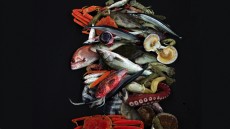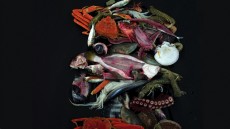
“Re-Modernologio” phase2 :Observation and Notation
October 23 (Sun) ~ December 18 (Sun), 2011 10:00 - 18:00 / Free
PAL Peter
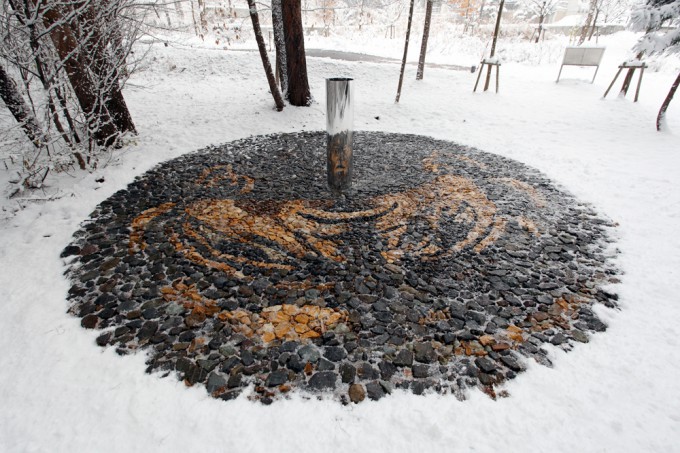
Anamorphosis 3, The sclpture you walk on
Intervention in Nature: Pal Peter’s pursuit of his perspective
KONDO Yuki
PAL Peter is an artist who has frequently participated in nature- and land-art exhibitions in recent years, in which artworks made through a so-called nature-related approach are shown. He also works as a restorer engaged in the restoration of church murals, the cultural heritage of his native country Romania. For this reason probably, his works show strong implications in history as well as nature around him.
Taking part in the artist-in-residence program of Aomori Contemporary Art Centre in the fall of 2005, PAL Peter produced Anamorphosis III reconstructed. As the title indicates, this piece employs the anamorphic technique. In anamorphosis, an intentionally distorted image is drawn or painted, and with a conical or cylindrical mirror placed on it, the drawing or painting is viewed from angles different from the usual, obliquely or horizontally, so that the image appears reconstituted as normal. Its approach is a sort of trick art technique, which has been popular for many years as the fruit of enjoyable playfulness and satire to criticize the system and society, which are not to be done openly. For an open-air piece, Pal collected local fieldstones in Aomori where he stayed, and embedded them in the ground to create a space similar to a stone pavement. At first glance, it appears to be a round open space paved with stones of various colors. Coming close to a certain point, however, you will find an image of a human face formed on the surface of a cylindrical mirror set up in the center. As the face is modeled after an Aztec mask, a contrast is made between a visible phenomenon (an ephemeral aspect of an image in front of me) and the established cultural history and tradition expressed in the form of the Aztec mask. This might coincide with Pal himself seeking to obtain his own way of contemporary expression while tackling a task of restoring historic relics. Artworks made for exhibitions of the artist-in-residence program are usually removed or dismantled after exhibitions, but this piece of Pal’s was left behind as an ACAC’s open-air sculpture.
About six years have passed since then. Partly because this piece was made temporarily for the exhibition, and in woods were plants growing between stones and activities of animals like moles coming out, stones laid all over moved gradually and the image reflected on the cylinder began to look distorted. Therefore, PAL Peter was invited to come back for the program with the primary objective of reproducing or restoring this piece. At the same time, he was asked to participate in Re-Modernologio phase 2: Observation and Notation to introduce his current activities. Pal agreed to the request, and besides reproducing/restoring Anamorphosis 3, he created a piece for the program exploring his own approach to analyze the key word “re-modernologio.” As Pal himself explains,[i] therefore, there is a clear line drawn between his way of involvement in this project “re-modernologio” as well as his approach to this key word and those of his Japanese counterparts. In the first place, rather than producing works from city people’s angles and/or using his collection of daily things, matters and phenomena, he has created many works through his intervention in the environment, nature and history around him.
As regards the subtitle “observation and notation,” he focused on “viewing” for the reason mentioned above. Pal’s new work this time is Another Place[ii] which provides us with a device to view scenery in a different way. In the center of a wooden frame is a round window made of polyvinyl plate and vinyl sheet filled with water. It functions as a convex lens and is placed in the center of a water terrace surrounded by a pine wood. What is shown on the part of convex lens is a scene turned upside down. In the scenery reflecting a shallow, clear pond with a mirror-like surface, an azure sky and the in-between pine wood, the surrounding trees look reversed on the pond and they turn around again on the lens-like part, so that it often becomes hard to tell the difference between the top and the bottom. Whichever it is, it becomes a fragment of the scenery because it is distorted once it is caught up in the frame and cut off from the scene around it, though it is simply a reflection of the surrounding landscape. Another Place, in which this distorted image emerges in the center, and Anamorphosis 3, in which a distorted image reflected on a curved mirror surface of a cylinder is visible as “normal” (as viewers believe), are presented as a pair of works. Pal intimates to us that a reality that we believe in is definite could be ephemerally distorted. He also states that the work symbolizes a feeling of freedom we have when we are released from fixed images and ideas as we change our viewpoint. There we realize that Pal contrasts his ephemeral current situation and solidly established history as well as his thoughts on our perception. At the same time, it seems that he is interested in how to view things and how their images are formed.
Both of these works for the exhibition share a common feature that “images become distorted through a viewpoint,” and so far he has produced many works using similar illusions and anamorphosis. The turn of the waters (2007) is an example of land art depicting an image by cutting plants with a sickle on the vast ground covered with rich green. Here, using a deforested area on a hill before his eyes, Pal made a square on the three-dimensional ground by cutting plants in straight lines starting from a certain point. This diagram is visible only from one certain point. As the stage where this work was developed is the vast ground, it would be difficult for visitors to find that point unless they knew his intention. On the other hand, however, even if you found this diagram, you would misunderstand the actual geographical features of the land due to the confusion caused by different undulations of the diagram. What is in prospect here is to change ephemerally the original form of nature by performing a little additional work to it.
After the exhibition started, Pal still kept working to produce his next piece for the program. This video work is The Arcimboldo sashimi. As the title suggests, it refers to portrait paintings by Giuseppe ARCIMBOLDO, a genius painter of mannerism in the latter stage of Renaissance in the 16th century. In his work, appropriating the Arcimboldo’s portrait series made entirely of such objects as fish, flowers and fruits to form precisely a likeness of the portrait subject, Pal produced and filmed imaginative portrait heads actually made of fish. As to this work, Pal mentioned that it showed his involvement in the artist-in-residence in Aomori.[iii] As fish used was cut and eaten at the very end, I believe that he tried to connect his work with “everyday life” in Aomori by depicting how its food culture is.
Pal has often produced new works by redoing old paintings, which are “masterpieces” so to speak. Pal interprets that borrowing from works of great masters in the past is the same as using the Aztec mask. It means a dialogue with old works, and he is probably thinking over today’s artistic viewpoint by replacing the perspective representation and image layout, which are historical art heritage invented by human beings, with the real. One cannot deny that his present work and his experience as a restorer tracing old works repeatedly to restore them overlap each other.
Art and Nature are conflicting words. Human beings have secured their “lives” using nature by acquiring “techniques.” In the art scene in Europe, for example, in Italian and French academies, the conflict between the two was obvious, because painting only nature was long denied its raison d’etre and landscape paintings were treated many years as low ranking. According to Pal, “Nature has its own form, which is like a system in which sculpture exists in nature. Natural forms are sculptural and the sculptural are like natural structures.”[iv] Though Pal does not consider nature and art to be conflicting, he seems searching for a kind of technique, that is, a system specific for integrating forms through intervening/getting involved in nature by using an everyday method. The great mixer which he is currently working on (2010-2011) is a concrete mixer made of very few tools and operated by man- and horse-power. It shows how Pal is creating a mobile piece through his production approach of intervening/getting involved in nature with minimum power. The work has no sense of conflicting values dividing nature and humans, and it reminds us of our history of primitive originality of human beings living on the earth.
[i] Interview conducted on December 11, 2011 for ACAC periodical “AC2” #13 (to be published in March, 2012)
[ii] Lens was used for the titled during the exhibition, but it was changed to Another Place.
[iii] Ditto
[iv] Pal’s lecture in the session of “Creation of Art” held at Aomori Public College on November 9, 2011.
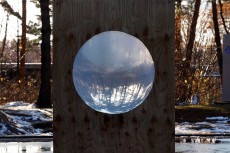
Another place

Another place
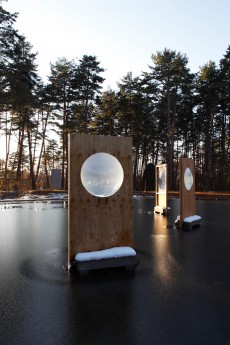
Another place
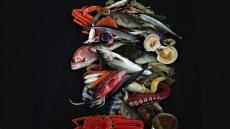
The Arcimboldo sashimi
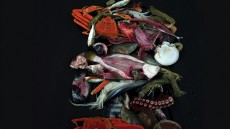
The Arcimboldo sashimi.
「再考現学 / Re-Modernologio」phase2 : 観察術と記譜法
2011年10月23日(日)~12月18日(日) 10:00 - 18:00/無料
パル・ペーター
PAL Peter

《アナモルフォーシス3 歩ける彫刻》
自然に介在する:パル・ペーターのパースペクティヴの模索
近藤由紀
パル・ペーターは近年、いわゆる自然とかかわるやり方で制作される作品によるネイチャーアート展やランドアート展に数多く参加しているアーティストであり、本国ルーマニアの文化遺産である教会壁画の修復に携わる修復家でもある。そのためであろうか、彼の作品には歴史への関わりと周囲の自然への関わりが強くみられる。
2005年国際芸術センター青森の秋のアーティスト・イン・レジデンスに参加したパル・ペーターは、作品≪アナモルフォーシス3 歩ける彫刻≫を制作した。この作品はタイトル通り、アナモルフォーシスの技法が用いられた作品である。アナモルフォーシスとはわざと歪んだ画像を描き、その上に円筒など曲面のある鏡面を置いて画像を反映させたり、斜めや水平などといった通常とは異なるポイントから画像を眺めさせたりすることで正常な画像を表すという一種のだまし絵の技法である。愉快な遊び心の産物として、あるいはおおっぴらには批判できない体制や社会に対する風刺画を描く技法として古くから親しまれてきた。パルは滞在地である青森県内から採集した自然石を地面に石畳状に埋め込み、野外作品としてこれを制作した。一見すると色の違う石が敷き詰められた円形の石畳の広場のようであるが、あるポイントにくると、中央に設置された鏡面状の円筒の表面に人の顔が結像するように作られている。この顔は、アステカ時代の仮面がモデルとなっており、そこには今、自分が目にしている現象/像のエフェメラルな様態とアステカ時代の仮面に託された確固たるものとして確立された文化的歴史や伝統が対比されている。そこには文化遺産の修復という歴史的遺物と日々対峙しながら自身の現在の表現を模索するパルの在り方が重なっているのかもしれない。通常、アーティスト・イン・レジデンス展のために制作された作品は、展覧会終了後に撤収されるが、パルのこの作品は、ACACの野外彫刻として残されることになった。
それから約6年が経過した。一時的な展示のために制作された作品であったことや、石の間に生育する草やその間から顔を出す土竜といった森の動植物の活発な活動により、敷き詰められた石は少しずつ移動し、円筒に映る画像に歪みを生じるようになっていった。そこでパル・ペーターは、この作品の再制作あるいは修復を主目的とした滞在制作を行うために再び招聘されることとなった。それと同時にパルの現在の活動を紹介するために「再考現学phase2 観察術と記譜法」への参加を依頼、パルはこれを受け、≪アナモルフォーシス3≫の再制作/修復と同時に「再考現学」というキーワードをパル・ペーターなりに読む解くことでアプローチした滞在制作作品を展覧会へ出品することとなった。したがってパル自身が述べているように[1]、今回の「再考現学」というプロジェクトへの関わり方およびこのキーワードへのアプローチの仕方は他の日本人作家たちのそれとは一線を画していたといえるだろう。そもそも彼の作品は、都市生活者の視点や、日常的な物や事や現象の収集から作品が制作されるというよりは、周囲の環境や歴史、自然との関わりの中で生み出されてきたものが多いのだから。
こうしたことからパルは副題である「観察術と記譜法」から「モノをみる」ということに焦点を定めた。パルが今回新作として発表した作品≪もう一つの場所≫[2]は、別の仕方で風景を眺めるための装置である。木枠の中央に水で満たされた塩化ビニル板とビニルシートによって作られた丸い窓は凸型のレンズのようになっており、それが周囲を松林でかこまれた水のテラスの中央に設置されている。このレンズ部分に映し出されるのは、凸レンズによって上下が反転した風景である。だがほとんど鏡面のような浅く澄んだ池と青く澄み渡った空が松林を挟んでそこに映し出される様は、周囲の木々が池の上で反転し、更にそれがレンズ状で反転するために、しばしばどちらが上か下かわからなくなる。いずれにせよそれは、周囲の風景のそのままの反映でありながら、フレームに捕らえられることで歪められ、周囲の風景から分断された風景の断片である。この歪んだ風景を中央部にとらえた作品≪もう一つの場所≫と、歪んだ像が曲がった鏡面によって「正常な」(と見る者がみなす)像を円筒に反映させる≪アナモルフォーシス3≫は、対の作品として提示されている。パルはこれについて、確かだと思っていた現実が儚く歪むことを暗示するとともに、視点を変えることで固定された概念や思想から解き放たれることの象徴でもあるともいう。そこにはパルのエフェメラルな現在とソリッドな歴史についての対比および我々の認識についての考察をみてとれる。そして同時にそこには物の見方、イメージとしての捉え方についての関心もみることができるだろう。
展覧会の出品作は両者ともに「視点によって画像が歪む」という共通点をもっているが、パルはこうした錯覚や歪像を利用した作品をこれまでいくつも制作している。≪水域の回転≫(2007年)は緑豊かな広大な大地に鎌をいれてそこに図像を描いたいわゆるランドアートである。ここでパルは目の前にあった丘の上の森林伐採の痕を使い、ある地点から直線状に草を刈ることで三次元の大地に方形を描いている。この図形はある一点からでしかみえず、広大な大地がその舞台になっているだけに、おそらく見る者はその意図を知らなければその点を探すことは困難だろう。しかし一方でこの図を見つけると現実の地形が図によって惑わされ、異なる高低で地形を認識してしまうようになっている。そこには自然に僅かに手を加えることで、もともとある自然の姿をつかの間変容させることが目論まれている。
展覧会がオープンしてからも滞在制作を続けていたパルが次に制作、発表したのは≪刺身 アルチンボルド≫という映像作品であった。それはその名の通り16世紀ルネサンス後期マニエリスムの奇才アルチンボルドがしばしば描いた肖像画――魚介、花、果物などを細密に描きながらそれらだけで人物像を描くシリーズ作品を――アプロプリエートし、実際の魚で人物像をくみ上げた映像作品である。パルはこれを「(滞在制作した)この場所に介在した作品」[3]と述べているが、それは最後にはそれらを捌いて食すところから青森の食文化をそこに反映させ、何かこの場所の「日常」と作品を結びつけようとした試みであるということだろう。
パルはこうした古いいわば絵画の「名作」を焼き直し、現実に表す作品をしばしば制作している。こうした過去の巨匠の作品の引用はパルにとってはアステカの仮面の引用と同じにとらえられている。それは古い作品との対話であり、人類が発明した芸術史上の遺産である遠近法やその画面構造を現実に置き換えることで現在の芸術的視点を考えていこうとする試みであろう。そこに常に古い作品をなぞり、修復してきたパル・ペーターの修復家としての背景を重ねない訳にはいかない。
ArtとNatureは対立する言語である。人類は「技」をもつことで自然に手を加え、自らの「生」を獲得してきた。ヨーロッパの芸術において例えばイタリアやフランスのアカデミーの中で長きに渡って風景画が単に自然を描くだけでは成立せず、いつまでもヒエラルキーの低い場所におかれていたことからもその対立は自明のものであっただろう。「自然はそれ自体の形がある。これは彫刻が自然の中に存在しているシステムのようである。自然の形は彫刻的であり、彫刻的なものは自然の構築物のようなものである」[4]と考えるパルは、自然と芸術を対立するものとしてとらえている訳ではないが、それでもやはり生の自然へごく日常的な方法で介在/介入することによってある形を統べる特殊な法則というある種の技を探ろうとしているといえるだろう。ごくわずかな道具によって作られ人と馬の力によって稼働するコンクリート製造機としての作品≪グレートミキサー≫(制作中)(2010 -11年)は、最小限の力を加えて自然に介入/介在するというパルの制作の手法を動的に作品化しているものといえる。そこには自然と人間を分け、対立するものとする価値観ではなく、その大地に生きる人間の原始的な創意の歴史を彷彿させる。
[1] 2011年12月国際芸術センター青森定期刊行誌『AC2』13号(2012年3月刊行予定)のためのインタビューより。
[2] 展覧会会期中は≪レンズ≫と題されたが、その後≪もう一つの場所(Another place)≫と改変されたため、本文ではこちらを使用することとする。
[3] 同上。
[4] 2011年11月9日青森公立大学「芸術の創造」のクラスにおけるパルのレクチャーより。

《もう1つの場所》

《もう1つの場所》

《もう1つの場所》
